 François Vivier Architecte Naval
François Vivier Architecte NavalHistorical and heritage open boats
 François Vivier Architecte Naval
François Vivier Architecte NavalI have contributed to the design of many heritage or historical boats. This page presents open ones. An other page is dedicated to decked boats.
| Hull length: | 5.73 m | Breadth: | 2.15 m | Displacement: | 750 kg |
Sail area: | 19.5 m² |
|---|
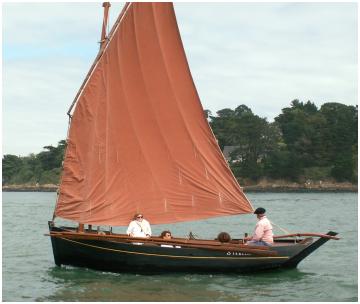 Sant
Budog was built by Chantier du Guip in 1986. Three sister ships
have been built by other builder. One of them, Annie, was
built in Cornwall. Sterenn (picture) is one of them. Sant
Budog was built by Chantier du Guip in 1986. Three sister ships
have been built by other builder. One of them, Annie, was
built in Cornwall. Sterenn (picture) is one of them.Sant Budog is a replica of the numerous "misainiers", boats with a single lug sail, used for inshore fishing in south Brittany during the first half of the 20th century. Sant Budog was designed on the basis of numerous measurements made by myself on wrecks or half models. |
| Hull length: | 6.2 m | Breadth: | 2.2 m | Displacement: | 1.5 t |
Sail area: | 34 m² |
|---|
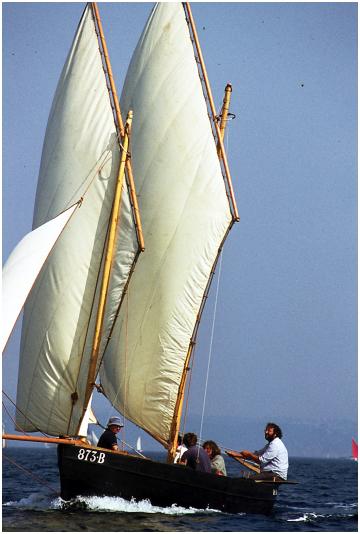 Les trois Sœurs was built by Michel Stipon and launched in 1984 for Bernard Cadoret, editor of Le Chasse-Marée.
Les trois Sœurs was built by Michel Stipon and launched in 1984 for Bernard Cadoret, editor of Le Chasse-Marée.She is a replica of boats used by a community of fishermen using to live on board with the family in the Brest bay. The lines plan is mainly based on pictures. The boat is very authentic, with the exception of a daggerboard which was included in order to improve windward ability. |
| Hull length: | 6.6 m | Breadth: | 2.58 m | Displacement: | 4.9 t |
Sail area: | 49 m² |
|---|
| Hull length: | 7.46 m | Breadth: | 2.6 m | Displacement: | 3.2 t |
Sail area: | 56 m² |
|---|
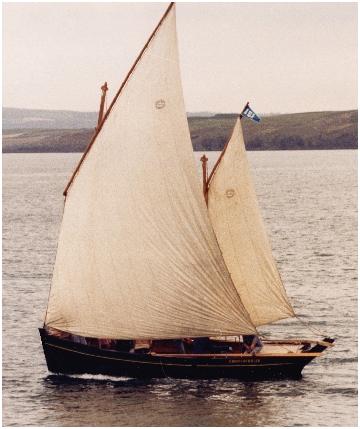 C'hoari w'an dour is a lug sail boat, as they existed in South Brittany in the years 1910 to 1930. C'hoari w'an dour is a lug sail boat, as they existed in South Brittany in the years 1910 to 1930.She was built in 1985/86 by Les Ateliers de l'Enfer in Douarnenez. She is still sailing in the Concarneau area. |
| Hull length: | 8.72 m | Breadth: | 2.9 m | Displacement: | 5.2 t |
Sail area: | 63.5 m² |
|---|
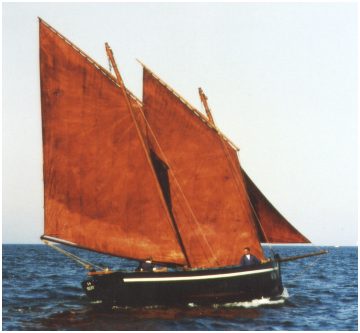 Poulligwen,
built in 1990 for a non-profit organisation of the harbour of Le
Pouliguen, is a replica of a crabber of the nearby harbour of Le
Croisic of the end of the 19th century. The boom on the mainsail is
typical of these boats and was not fitted on the more common sardin
boats of that time. Poulligwen,
built in 1990 for a non-profit organisation of the harbour of Le
Pouliguen, is a replica of a crabber of the nearby harbour of Le
Croisic of the end of the 19th century. The boom on the mainsail is
typical of these boats and was not fitted on the more common sardin
boats of that time.Design is based on the plans of similar boats and pictures. |
| Hull length: | 8.84 m | Breadth: | 3.48 m | Displacement: | 9.9 t |
Sail area: | 83.5 m² |
|---|
| Hull length: | 9 m | Breadth: | 2.2 m | Displacement: | 1.3 t |
|---|
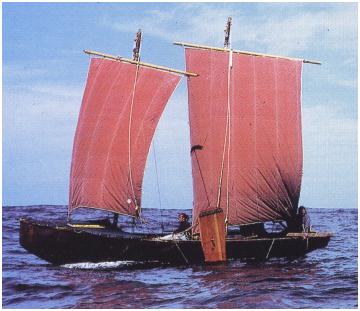 Built
by the association "Aux marches de
Cranou" in Brittany, Saint Efflam was built after extensive historical
researchs about the voyages made by celtic monks before year 1000. The
hull is covered by leather over a wooden structure, on the same
principle than Irish curraghs. Built
by the association "Aux marches de
Cranou" in Brittany, Saint Efflam was built after extensive historical
researchs about the voyages made by celtic monks before year 1000. The
hull is covered by leather over a wooden structure, on the same
principle than Irish curraghs.Saint Efflam has made a long voyage aroung Ireland. I have drawn the lines plans, taking in account the construction constraints. |
| Hull length: | 9.1 m | Breadth: | 3.05 m | Displacement: | 4.9 t | Sail area: | 64 m² |
|---|
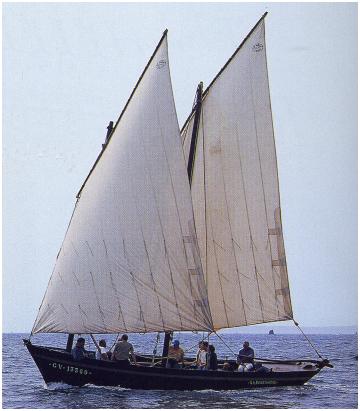 In
the very first years of the 20th century, sardin boats of the
'bigouden" country in South west Brittany, used an unusual stem shape. In
the very first years of the 20th century, sardin boats of the
'bigouden" country in South west Brittany, used an unusual stem shape. La Barbinasse was built in 1997. She is the first boat built with full size patterns printed on polyester films, a technique I have improved year after year. Fortunately, she is not fitted with an inboard engine, keeping the speed of pure sailboat. |
| Hull length: | 9.18 m | Breadth: | 3.4 m | Displacement: | 10.1 t | Sail area: | 76 m² |
|---|
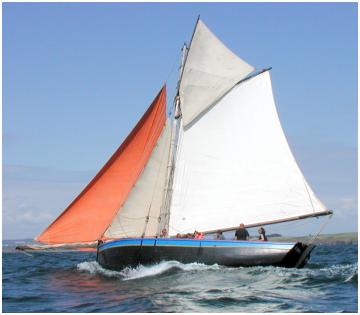 Enez
Koalen is a replica of a lobster cutter of the begining of the 20th
century, from the harbour of Loguivy (near Bréhat island, in northern
Brittany). Enez
Koalen is a replica of a lobster cutter of the begining of the 20th
century, from the harbour of Loguivy (near Bréhat island, in northern
Brittany).She has less transom rake that the famous "langoustiers" of the Iroise sea (Camaret). She is half decked and was initially not fitted with an engine. Enez Koalen is now owned by Voiles et Tradition, a company operating several traditionnal boats. |
| Long. coque: | 9.6 m | Breadth: | 2.72 m | Displacement: | 6.1 t | Sail area: | 50 m² |
|---|
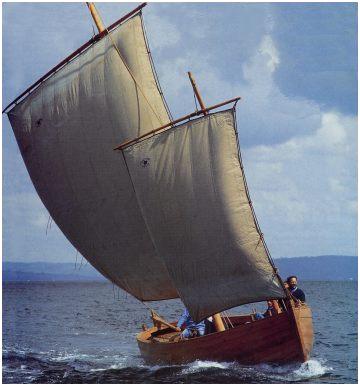 An
exceptionnal boat, which seems to come out of Ozanne or Morel Fatio
engravings of the maritime life of the 18th century in the Brest area.
Plougastel boats were used to transport people and goods inside the
Brest bay. The rig is typical of the first evolution from the old
square sail to the lug sail : masts are raked aft, yards are hung at
one third (or less) of their length and just the sail foot has been cut
out. Simultaneously, the boat is trimed back is order to improve the
lateral resistance and then the widward ability. An
exceptionnal boat, which seems to come out of Ozanne or Morel Fatio
engravings of the maritime life of the 18th century in the Brest area.
Plougastel boats were used to transport people and goods inside the
Brest bay. The rig is typical of the first evolution from the old
square sail to the lug sail : masts are raked aft, yards are hung at
one third (or less) of their length and just the sail foot has been cut
out. Simultaneously, the boat is trimed back is order to improve the
lateral resistance and then the widward ability. |
| Long. coque: | 10 m | Breadth: | 3 m | Displacement: | 6.4 t |
|---|
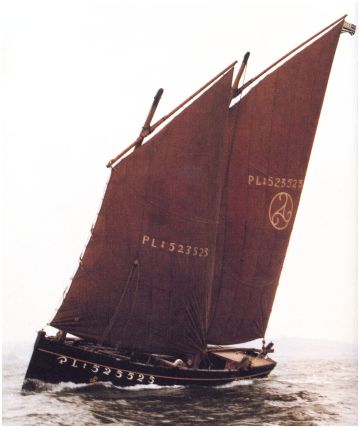 Yvon
La corre is both an unequaled artist and sailor. Both are linked as his
boats have always been a mean to wander with paper and pencils and come
back with awesome illustrated notebooks. Yvon
La corre is both an unequaled artist and sailor. Both are linked as his
boats have always been a mean to wander with paper and pencils and come
back with awesome illustrated notebooks.When the first volume of Ar Vag, was published, with an extensive description of Breton sardin boats, he wanted to rebuild one of them. Eliboubane was built in 1981 by Daniel boatbuilder in Paimpol on a line plan drawn by myself on the basis of historical plans. Original sardin boats had a crew of 7, but Yvon was frequently alone or with only a few people on-board. So he tried many rig arrangements, to avoid gybing the sails when tacking. |